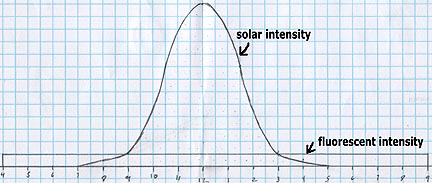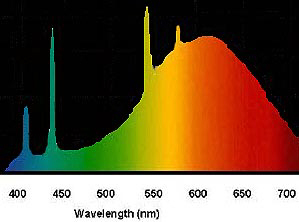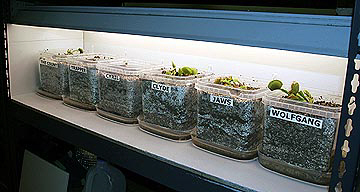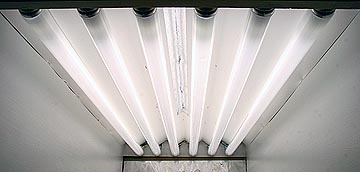
Brightness versus time curve for unshaded sunlight on a clear and bright day

FLUORESCENT PLANT LIGHTING What I learned from experiments in growing plants fluorescent lights.
When
I became interested in growing Venus
Fly Traps I reasoned that it would be more convenient to grow
them inside under artificial lights. That way I could put them on an
eye-level rack to make feeding them and watching them easier. The
problem to solve was determining what type of lights to use. This
page chronicles what I discovered from reading dozens of artificial
lighting websites on the Internet and how applying this information
worked for my plants.
There are two primary factors that must be considered when setting up an artificial lighting system: amount of light and quality of light.
The amount of light is the product of its intensity (how bright it is) multiplied by how long it shines on the plant. Outdoors, sunlight goes through a daily cycle of starting off dim, building toward a maximum around noon, then weakening until sunset.

Brightness versus time curve for unshaded sunlight on a clear and
bright day
The area under the bell-shaped curve is the total amount of light the plant receives from the sun. Because it's difficult to reproduce the sun's intensity indoors, an artificial system has to be left on longer to compensate for its reduced brilliance, 12 to 18 hours a day is usually required. (Except under special conditions and for particular plants leaving the lights on 24 hours a day is not recommended. Most plants require some darkness everyday for proper growth.) Although artificial lighting is usually not as bright as natural sunlight, it has the advantage of being constant as long as it's on. Unlike the bell curve for natural sunlight this creates a constant rectangular area, as shown by the "fluorescent intensity" area on the graph. As long as the areas under both curves are close the plants should grow at approximately the same rate.
At first glance it would appear that even with being on for 18 hours the fluorescent lamps provide much less total energy (18 units) than the sun (96 units.) But, for growth plants only absorb 25-percent of the solar spectrum. All of the rest, mainly in the green and yellow zone, is wasted. Multiplying the sun's 96 units by 0.25 gives 24 units of energy useable by the plant, still more than the 18 from the fluorescent lights but close enough for good growth. (Another way of thinking of this is that the light from fluorescent grow lights looks four times brighter to plants than they do to us.)
If you want to measure the intensity of your own lights for comparison to the sun you can do so with almost any camera that has a manual mode. Set the aperture to f5.0, the ISO to 200 and focus the camera on a 17-percent gray card purchased from any camera store, being careful to avoid angles that send glare into the lens and so that the card completely fills the field of view. Adjust the shutter speed to get a good exposure. The brighter the light the shorter the shutter speed has to be set. This represents your yardstick: the shorter the shutter duration the brighter the light.
In my experiments, using a Canon EOS 20D camera, I found that shade and overcast days required a shutter speed of 1/1000 second, noon time sun was around 1/2500, and the light set-up for my plants is only 1/200 second but remember, almost 100-percent of this light is used by the plants whereas only 25-percent of the sun's light is used. There are special-made light meters designed to measure the amount of light utilized by plants. These are not the cheap units available in hardware stores or nurseries and can be quite expensive.
As
already mentioned in the discussion on intensity, the second primary
factor in artificial lighting is the quality of light. Oddly, with
this factor we don't necessarily want to copy the sun. Consider the
following graph showing the amount of power provided by the sun as a
function of wavelength:

Solar Spectrum or Spectral Power Distribution Curve
The sun is brightest at around 520 nanometers, corresponding to a black body radiating at 5,800 degrees Kelvin. Light at this frequency is yellow-green and is the color to which our eyes have adapted for maximum sensitivity. Curiously, this is not the color to which plants have optimized their absorption to drive their growth. Instead, they use primarily blue and red light as the following graph shows:

Plant Absorption Spectrum
The reason plants look green is that they reflect most of the green light away (as evidenced by the very low amount of green and yellow absorbed) while using the blue (for energy, chlorophyll production, and stem growth) and red (root development, tuber formation, dormancy, and reproduction.)
This gives an advantage to artificial lighting because it enables the spectrum of the light source to be tailored to match the plant's requirements without wasting a lot of power generating light at frequencies that the plant can't use. Since the lights are going to be on a lot of time, a high-efficiency system is desirable to keep electricity costs down.
Besides the primary factors of light quantity and quality, anyone wishing to use artificial lights for growing plants needs to consider secondary factors such as purchase cost, ease of installation, maintenance, electricity costs, heating problems caused by the lights, and so on.
After evaluating all these factors I decided the optimal solution for my lighting needs was a fluorescent system using two, 48-inch 2-tube fixtures. The fixtures were on sale for only $8.00 each at Walmart, installed easily, the tubes last for years (more on that later) are electrically the most efficient producers of light, they produce very little heat, and the spectrum (through a judicious selection of tube type) is the closest match to the plant's needs.
Regular incandescent lights are too inefficient and don't produce enough blue light for healthy plant growth. They also produce too much waste heat.
Many websites recommend high intensity discharge systems because they provide the brightest light and can produce a spectrum very close to sunlight. The problem with such systems for me is that they produce so much heat that they would create cooling problems in my desert location. Also, a small system like I need would have been several times as expensive and complicated to install as a fluorescent one and would be extremely costly to operate continuously.
So, fluorescents were the best option for me. The problem is that although they look bright inside they're are very weak compared to sunlight. Leaving them on for a large part of the day helps compensate for this as well as enclosing the growing chamber with walls painted white to reflect as much light as possible back onto the plants rather than escaping out of the sides and being wasted.
The light from a point source like a normal incandescent bulb falls off by the square of the distance: doubling the distance from the bulb reduces the intensity by a factor of four. Because a fluorescent tube is a long source rather than a point source, intensity falls off more linearly when the plant is close: doubling the distance reduces the intensity by half. With a 2-bulb fixture in a reflector (the typical and inexpensive shop light set-up) the intensity falls off even slower, about 1.5 times the increases in distance. For my setup, with the lights and plants enclosed in a white box, the lighting is almost perfectly even so that it's constant within 8 inches of the bulbs. This is convenient because it means I don't need to continually adjust the elevation of the plants as they grow. Better still, all that light being reflected back onto the plants increases the intensity of the light by a factor of two. Just as important is that the cool running of the fluorescent bulbs means that the inside of the growing chamber doesn't heat up as it would with a HID system.
The last issue to be resolved was what type of bulbs to install in the fixtures. My first thought was to use bulbs labeled as "daylight," thinking that they would be the most natural. The problem, as the following spectral power distribution curve indicates, is that while these produce enough blue light they are weak in the red zone and waste a lot of electricity producing lots of green and yellow light.

Daylight Deluxe Light (6500 K)
I read in several sites that using a combination of warm spectrum lights (for the red) and daylight or cool lights (for the blue) was a good way to go. The following spectrum of a warm light suggests that this might work, it's certainly rich in red. (Note: non-deluxe or non-plus type daylight bulbs are weak in the red zone. I also found that cool-white types are weaker in blues and greens than daylight types.)

Warm Light Deluxe Light (4100 K)
The problem is that such mixtures of bulbs still produce an over abundance of green and yellow light, which is a waste of energy. (Note: non-deluxe or non-plus type lights are also weak in the red zone.)
Fortunately, the fluorescent light industry has come to the rescue by producing special plant growth lights with phosphors selected to produce light in a spectrum that almost perfectly matches the absorption spectrum of most plants, as the following graph shows:

Plant/Aquarium Light
It is important to note that the vertical scale on this last graph is much more compressed than on the previous two. Plotted to their scales this chart would have power maximums that were three times higher than the others. I assume from this that plant lights appear to be very efficient in producing only the right type of light. The lights I use are GE Plant and Aquarium Wide Spectrum lights. (I've read that Philips produces a grow light called Agro-Lite that is supposed to make plants grow 2-10 percent faster, but none of the stores in my area carry it.)
The sharp spikes in the spectral power distribution curves are the colors emitted by the mercury vapor inside the tubes as electrons flow through it. The more continuous spectrum, and the source of most of the bulb's light, is from ultraviolet light from the mercury striking the phosphor coating inside the tubes and making it glow. One source claimed that while fluorescent bulbs may last many years, the light output for growing plants decreases significantly with time and should therefore be replaced every 6 months. The source failed to mention if this was 6 months of actual "on" time or just daily use.

My
fluorescent light growing chamber, small but efficient.
How does it work? Unfortunately Venus Fly Traps grow so slowly that it's hard to make comparisons. I have been able to do so by growing cantaloupes for transplanting into my garden. In 8 weeks I grew a plant from seed to one with several 18-inch long vines. This required leaving the lights on 18 hours a day. The same type of melon grown outside in sunlight grew 50 percent larger in the same amount of time. Both plants were equally heathy and robust.
Beware
of "Watts-Per-Square-Foot"
Recommendations
I came across many of these while researching my system, ranged from 10 to 40 watts per square foot. The problem with such recommendations is that they say practically nothing about the amount of light placed on a plant. First, different type bulbs vary greatly in the amount of total light (measured in lumens) they produce. Incandescent bulbs can produce as little as 13 lumens per watt whereas fluorescents can be as high as 85 lumens per watt. Second, bulb shape, reflector configuration and the distance of the plant from the light have an enormous impact on the amount of light a plant receives. Finally, the color or spectrum of the light greatly influences how well the plant can use the light hitting it. Only 20-percent of the light from an incandescent lamp is used while virtually 100-percent of the light from a good fluorescent grow lamp will be absorbed.
Consider a 100-watt bare incandescent bulb 1 foot away from a plant covering one square foot of area. Such a lighting set-up will shine 108 lumens onto the plant's one square foot of which the plant will only be able to use 20 lumens. This is so dim the plant might as well be locked in a dark closet. One the other hand, consider a 100 watt fluorescent grow light equipped with a good reflector. It will produce 8,000 lumens, of which 7200 can be channeled onto and used by the plant (some losses are unavoidable.) This is enough light for any plant to flourish. Clearly, citing a "watts-per-square-foot" recommendation is not the best way to design a plant lighting system.
Another problem to consider is the design of the bulb's reflector. Many long fluorescent fixture place the bulb so close to the reflectors that much of the light is trapped and lost behind the bulbs.
Beware
of blue "plant lights"
I've seen spotlights with the front painted blue being sold as "plant lights." When I read the description, it always states that they "Make plants look greener." These colored lights just make the plant look good, they aren't the same as grow lights.
How
does my
inside system compare to growing plants outside in sunlight?
By measuring the rate of leaf growth I was able to estimate that my lighting system grows plants about as fast as plants placed outside against an east-facing wall where they only get direct morning sun until 1 PM. Plants growing against a south-facing wall painted white to reflect extra light into them grow twice as fast as those under my system.
IMPORTANT UPDATE!!!
Plant Growth Comparison
Several months after posting this page I started doing Internet searches for information on which type of fluorescent grow lamp produced the best growth. I was surprised to discover than I couldn't find a single, unbiased comparison test so I desided to conduct my own.
I found four different fluorescent plant lights at the local hardware stores: GE Plant and Aquarium, Sylvania Gro-Lux wide spectrum, Philips Plant and Aquarium and the Ott-Lite Plant Growth light. As a standard, I purchased GE Kitchen and Bath bulbs because they had the brighest lumen rating. Here's what they look like:

Front
top to bottom: GE Kitchen and Bath (very yellow)
Ott-Lite
(strongly blue)
Sylvania
Gro-Lux Wide Spectrum (whitish, faintly grey-pink - the bulbs have a
speckled appearance)
Philips
Plant and Aquarium (very pink)
GE
Plant and Aquarium Wide Spectrum (whitest looking)
I
constructed five identical growing boxes, one for each lamp type and
a fifth for the brightest fluorescents I could find: GE's Kitchen and
Bath bulbs which put out 3400 lumens each compared to the 1600-1800
for the plant and aquarium bulbs. I planted the same number and type
of Zinnias, tomatoes, Salvias and melon seeds in each growing box.
All the boxes were kept in the same room and positioned to ensure
they all remained at the same temperature and had the same access to
fresh air. I was careful to make certain that they all used the same
potting soil and received the same amount of water.
Additionally, I set up an identical set of planters for outside growth. These will show how well the artificial lighting systems work compared to nautural sunlight. These were brought in every night and kept in the same room as the artificially lit plants to maintain as many variables the same as possible.
Results:
The following image shows how a single variety of zinnia grew under the various lighting systems:

Front
top to bottom: GE Kitchen and Bath
Ott-Lite
Sylvania
Gro-Lux Wide Spectrum
Philips
Plant and Aquarium
GE
Plant and Aquarium Wide Spectrum
Natural
Sunlight
GE Plant and Aquarium Wide Spectrum lights clearly did the best with GE Kitchen and Bath lights a close second. The much-touted Ott Lites were the worst. Most remarkable is that many plants did better under the artificial conditions than those grown in natural sunlight. I assume this is because the artificially lit plants had more uniform growing conditions. I got essentially the same results using tomatoes and melons as the test plants. What this experiment convinced me of is that in the future I will be using GE's Plant and Aquarium Wide Spectrum lights for all my artificial plant lighting.
My
first system making use of all this information consisted of a
15-inch wide by 48-inch long bright white box with two light fixtures
loaded with four GE Plant and aquarium bulbs. A small fan at one end
blows through the box to provide a constant supply of fresh air for
them to breath as well as to prevent the build up of excess humidity,
which can lead to diseases such as damping off. Each side consists of
two sheets of perforated masonite thumb-screwed together. As the
plants get taller one of the two sheets on each side can be lowered
to give the plants more head room. Although this box worked well, it
was too small (only holds 30, one-quart planters) and moving the
sides up and down got to be a hassle.
My second system was 2-feet wide and high and again 4-feet long, providing enough room for 50 quart-sized planters. By painting the top, sides, ends and bottom bright white enough light is retained so that for all intents and purposes the light strength is constant over the entire height of the box. This means the plants don't have to be moved up or down during the growing season. Three, 2-bulb fixtures screwed to the underside of the top provide enough light so seedlings grow fast, dark green and stocky, indicating that they are receiving plenty of light.
The one thing that I still didn't like about such growing boxes is that the reflectors on the light fixtures are so close to the tops of the bulbs that much of the light given off is trapped between the bulb and reflector and therefore wasted.

To address this problem I built a second version of the larger box, this time with the bulbs mounted directly to the box. A series of "V" shaped reflectors were positioned over the tubes so that the maximum amount of light was extracted from the back side of the bulb and redirected down toward the plants.

Comparing the two systems with a light meter showed that the improved design increased the amount of light on the plants by 25-percent. As good as this sounds I doubt I will modify the first larger box because the amount of work required is enormous and extremely tedious. Besides, the first big box does just fine.
T5
Bulbs :
I've been following the growth in popularity of the new T5 fluorescent bulb systems and have to admit that at first blush they sound pretty good. T5 bulbs are smaller in diameter than standard fluorescent bulbs, making reflector design easier and more efficient. They produce more light per watt than regular fluorescents, sometimes as high as 95 lumens per watt.
However, to my thinking there are two problems with the new bulbs. First, the bulbs, holders and reflectors cost ten times as much as standard systems yet only produce 25-percent more light. Second, although they are specifically targeted at the indoor gardener there is very little information available about spectrum optimization. For example, many of these "plant" bulbs are full spectrum lights that mimic the solar spectrum. As already discussed, this is not efficient for artificial lighting schemes. Also, as of May of 2009 no one I've found makes a true "plant light," one that have its maximum intensity in the blue and red zones. Rather they only offer dedicated blue and red bulbs that have to be mixed and matched to produce an optimum mix spectrum. This might be acceptable but the spectral distribution of these lights isn't provided. How sharp are the peaks? How many sharp spikes are there and how does their intensity relate to the power in the phosphor light profile? How many red lights should be mixed with blue bulbs for optimum growing conditions?
With so many unanswered questions coupled with the exorbitant price this is a technology I can do without until it matures. For $15 I can add an extra set of lights to one of my grow boxes and produce just as many lumens as a high-tech T5 system costing over $200.
Fluorescent Bulb Brightness Test:
I've read that fluorescent bulbs weaken with time so that after six months their light output is cut in half. The problem with such claims is that I haven't found one that defines the duty cycle: whether they were used 10 hours a day, 14, or 18. To answer this question in March of 2009 I set up a GE Plant and Aquarium bulb on a timer to cycle it on for 16 hours a day. In front of it I secured a digital camera to record the amount of light given off. The camera's settings were selected so that a decrease of less than 10-percent would be detected. Here's what I found:
April
(31 total on-off cycles): no decrease in brightness.
May
(61 total on-off cycles): no decrease in brightness.
June
(92 total on-off cycles): no decrease in brightness.
July
(123 total on-off cycles): no decrease in brightness.
Aug
(155 total on-off cycles): a 10-percent decrease compared to the
original brightness.
Sep
(186 total on-off cycles): a 10-percent decrease compared to the
original brightness (in other words: no change since last month.)
At this point I'm considering this experiment over. It established that at the settings used, GE Plant and Aquarium wide spectrum fluorescent bulbs do not loose half their brightness in six months. They do get weaker, but only by 10-percent.
So how long is a fluorescent bulb good? In as much as the amount of light in an enclosed light box, such as those described on this page, is borderline for many plants, I intend replacing my bulbs after six months of use.
Return to my main site for more gardening pages or browse over 90 other topics: everything from electric rocket engines to Knitting Nancys.